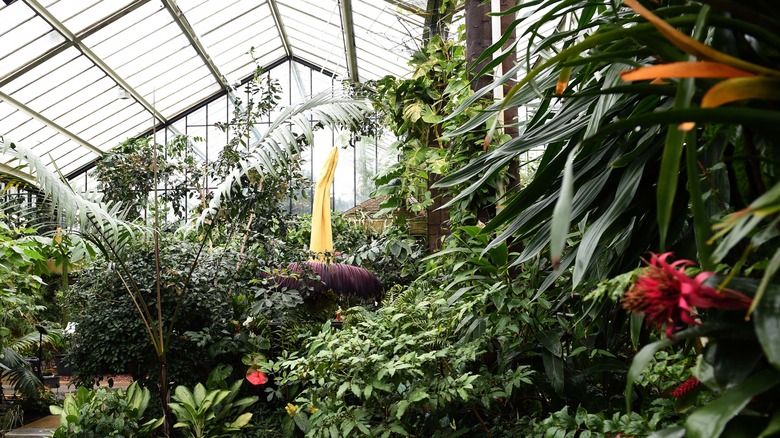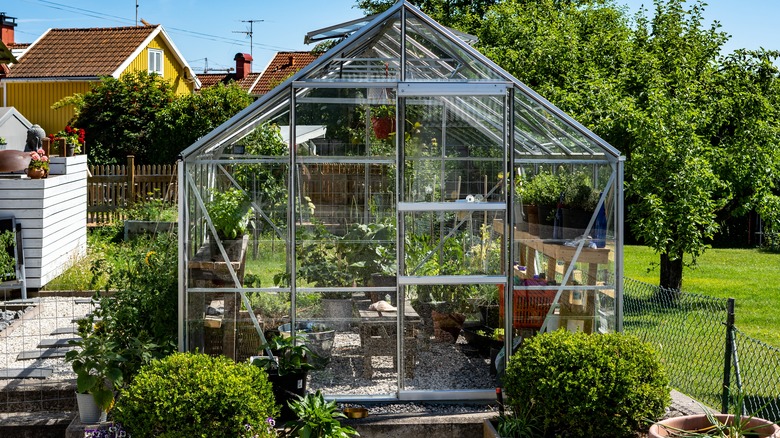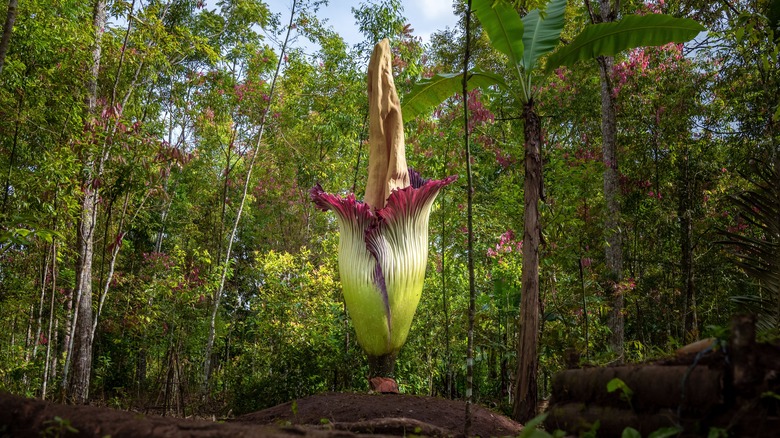Grow This Gigantic Tropical Flower With A Morbidly Dark Name For A Unique Garden
For those looking to create a moon garden, a goth garden, or just a unique garden, there is one ultimate flower that rises above all others (literally). The corpse flower — also known as Amorphophallus titanium — is a giant tropical flower that is so oversized, striking, rare, and unique that it is featured in many botanical gardens, conservation centers, and zoos around the United States and beyond. Listed as endangered by the International Union for Conservation of Nature (IUCN), it is estimated that less than 1,000 living wild corpse flowers remain worldwide.
While the corpse flower may look beautiful and stuns at up to 12 feet tall when full-grown, the bloom only opens for a few days once per year (at most) after the first 7 to 10 years of its lifespan. When it does finally bloom, it emits a scent that is reminiscent of decomposing flesh (hence the plant's morbid name). This plant also requires extremely specific and meticulous care. If you're an advanced gardener who's ready for a high-level challenge and a spooky aesthetic, consider this your guide to growing the dark and mysterious corpse flower.
Preparing to grow a corpse flower
Planting a corpse flower is easy. All the tuber requires to start is an 8-inch pot (unless you happen to live in tropical hardiness zone 10, where the plant can grow in the ground), some well-draining potting soil, and a high-phosphorus water-soluble fertilizer. As Amorphophallus titanium rapidly grows, however, you'll need to be prepared to provide it with a more controlled environment, along with containers of increasing size and depth. After 5-10 years, your corpse flower could weigh up to 300 pounds (not including its soil)!
Since the giant plant will become difficult to move very far after a few years, you'll need to be prepared to place it in a permanent home that meets its very specific requirements for growth. Typically, this equates to buying or building a greenhouse or sunroom with a ceiling higher than 12 feet that can offer bright, indirect light, daytime temperatures between 80°F and 90°F, nighttime temperatures around 75°F, and 89-90% humidity. Since the corpse flowers' roots are prone to rot, you'll also need a strong surface that can keep the plant's pot elevated a few inches off the floor without collapsing under its weight.
How to care for your corpse flower
Once you've prepared yourself and your gardening space for your corpse flower, get ready to provide your new tropical giant with continuous care for up to a decade without ever seeing it bloom. Be sure to keep the plant's environment warm and humid enough, always. In cooler temperatures, the plant will go into dormancy — delaying blooming even further. If your corpse flower is exposed to temperatures colder than 45 degrees Fahrenheit, it is likely that is will not survive.
Water your corpse flower as soon as its top soil feels dry. During the active growing season, add a liquid fertilizer at every watering. Toward the end of each growing season, you'll notice the plant's growth begin to slow. Eventually, its one oversized leaf and the attached stalk will rot and fall off. At this point, the corpse flower should be carefully repotted into a larger container with fresh soil. After a period of dormancy, a new leaf will grow, and the cycle will repeat. Once the tuber's corm reaches a size of about 50 pounds, the flower should bloom for the first time.


